
What Are Essential Oils?
Essential oils are volatile, aromatic chemicals obtained by steam or hydrodistillation of various parts of plants, including seeds, bark, leaves, stems, roots, flowers and fruit. They are highly concentrated, beneficial secondary metabolites that serve as the defense mechanism of the plant. Although plants do not have an "immune system," to thrive they must be able to resist the challenges of bacteria, fungi, viruses and be able to defend themselves against herbivores. They must attract pollinators, thus they are also the communication system of plants.
Essential oils can help balance and support the body to heal itself. Research has shown that essential oils help us fight infection, contain balancing compounds and aid regeneration. They possess anti-bacterial, anti-fungal and anti-viral properties. Kurt Schnaubelt, PhD wrote, "Essential oils do not act as weapons but as agents of interaction. They are a key ingredient of life itself, strengthening its fabric and preconditions." 1
The molecules of essential oils are lipid soluble and relatively small, giving them the ability to easily penetrate the cells and travel throughout the body in a matter of minutes when inhaled, applied topically or taken by mouth. Price notes that: Essential oils "can pass the blood-brain barrier and access the central nervous system. The degree of lipid solubility varies from one class of molecule to another." Once past this barrier, there is the potential to bring benefit and bring harm, as "there is the potential for toxicity. For example, an accidental overdose of Syzygium aromaticum [clove] (5-10 mL) produced convulsions in a child." 2
Essential oils have their own individual character or "blueprint" – an absolutely unique identity. Their potency allows them to be used in a small quantity for beneficial and effective results. Using the sun's energy, soil, air and water, a perfectly balanced blend of complex components is created. The combination of numerous elements gives each oil its individual fragrance along with its particular beneficial and healing properties. It is impossible to synthetically reproduce an essential oil in its exact form.3
There are four basic ways to use essential oils: through the lungs (inhalation), through the skin (massage), through the digestive tract (by mouth) and through the absorbent tissues of the body orifices (suppositories or orally absorbed – not swallowed). Holding a drop of a suitable essential oil in the mouth allows them to be absorbed directly into the bloodstream. Swallowing the oils results in a major portion being destroyed by the stomach acids, so a greater amount of oil is required when swallowed than when simply held in the mouth, but since some oils are too strong to be held comfortably in the mouth, and when internal usage is deemed appropriate, swallowing oils in a capsule is an effective alternative. The choice of usage should best fit the need.
We are very enthusiastic about the use of essential oils because we've seen how wonderfully they have worked in our lives and for our family members and close friends. Our desire is to share what we know and have experienced and to help others as we have been helped. Of particular interest will be the numerous testimonies provided for you in our Health Care Testimonial section. If you ever have a testimony to share, please send it our way so we can share it with others.
Quality Matters
We feel in awe of what the Lord has given us in these oils and a great deal of respect for the call we feel to help others learn about using them. We've been privileged to witness some amazing results of using the oils guided by the Lord through prayer.
We want to be sure that at every step, from growing the plants, harvesting and distilling, that the utmost care is taken to ensure that the quality of the essential oil is not compromised. It is imperative to only use high-quality essential oils grown and distilled biocide-free, harvested at the optimal time and distilled with the appropriate care to produce the highest quality oil possible.
Hopewell Essential Oils uses only the highest quality oils available. All our essential oils are 100% authentic, grown on biocide-free farms or land, in soil nourished organically (without pesticides, herbicides, fungicides, chemical fertilizers and so on). We use the term "unsprayed" to indicate biocide-free plant material. Before purchasing each oil, we verify its quality and will not purchase an inferior oil even if we must wait until the next harvest or longer.
For more detail on quality, see our Statement of Quality.
Safe Use of Essential Oils for Health Issues
For those new to the wonderful world of using premium-quality essential oils for health issues, the subject of safe usage is of top importance. There are differing perspectives about essential oil usage, and discerning the viewpoint of the author usually helps bring understanding to what seems to be conflicting information. In some books you may find dire warnings about the use of Cinnamon and Clove oil, which admittedly can be *irritating* but nevertheless highly effective antimicrobials and top choices for someone fighting viral or bacterial infection. The warnings are there because one can cause a serious, painful chemical burn if they use Cinnamon Bark undiluted on the skin. When used appropriately diluted as needed, we can effectively use a few drops of Cinnamon Bark or Clove to help end a debilitating condition rather than be fearful. The warnings encourage the user to exercise discernment. According to chemist, aromatherapist and author Dr. Kurt Schnaubelt, "Most warnings [about essential oil usage] are derived from industry-funded dermatological tests with limited relevance for aromatherapy."4
For those seeking natural, healthy alternatives to conventional medications, we can embrace an integrated perspective about the use of these amazing oils and quickly gain an understanding of the relatively short list of cautions.
With some basic information and discernment (common sense), one can safely explore many uses of essential oils for almost any health issue. Even an unpleasant experience is usually short-lived and the knowledge gained becomes helpful for future applications. Simply applying additional carrier oil should immediately reduce the unpleasant irritating effect on the skin. A temporary irritation from an improperly diluted essential oil pales very quickly when we consider the untold senseless deaths and side effects caused by conventional medications. There is plenty of room to comfortably and safely explore essential oils and their potential applications without causing harm.
"To get out from underneath these layers of trumped-up concerns, the whole safety and toxicity discussion needs to be turned upside down. Instead of perpetrating mantras about imaginary dangers, the inherently benign nature of essential oils needs to be recognized." Schnaubelt notes that many aromatherapy "rules" are not "justified by any perceivable reality."4 - Dr. Kurt Schnaubelt
Schnaubelt points out that some of the oils designated as "forbidden use" are among the most therapeutically useful, and "even the safety of essential oils during pregnancy discussion seems to abate due to the stubborn absence of reports of any adverse effects." Schnaubelt goes on to say that "the much-feared potential of Rosemary oil to induce seizures has so far failed to throw all of Britain into a collective state of epilepsy."4
When one uses essential oils by the drop, you quickly develop a sense for any real side effects, such as skin irritation. Schnaubelt notes that: "Many popular aromatherapy texts mention the ability of essential oils to stimulate detoxification." Dr. Jean Valnet states in The Practice of Aromatherapy that "Lemon oil is effective against liver stagnation. Today cellular and molecular biology let us understand why this is so! A large proportion of essential oil components induce so-called Phase I and Phase II liver detoxification enzymes. That this capacity was recognized by traditional healing systems specifically for Lemon oil is probably more of a consequence of its ample availability and easy use than singular efficacy."5
Essential oils may linger in a healthy body for up to eight hours, but generally, it is felt that they are mostly metabolized and eliminated in 1-2 hours, so reapplication every couple of hours may be desirable for an acute need.6
Topical Use
If you are new to using essential oils, start slowly and remember that they are highly concentrated, and a little will go a long way. If you are using a new oil or blend for the first time, test it on a very small area first to be sure your dilution rate does not cause skin irritation. Some people test oils at the bend of the arm opposite the elbow or on the wrist. In some cases, the essential oil may be tolerated initially but can cause dermatitis reactions with subsequent use. Cinnamon and Clove statistically have the capacity to sensitize more than others, but interestingly, "these effects are related to topical application; it appears, from experience in the aromatherapy community, that the internal application does not carry the same risks."7
Carriers: Carriers are used to dilute or "extend" essential oils so that they can be safely applied to the skin. There are a wide range of carriers, many of which are oils that are cold pressed or macerated from plants, nuts and seeds. Common carriers include Almond oil, Aloe Vera, Avocado oil, Argan oil, Coconut oil (fractionated or virgin), Emu oil, Grape seed oil, Jojoba oil, unscented Lotion, Pomegranate, Tamanu oil, Vegetable Glycerine, Witch Hazel and so on. Infused oils are a combination of a carrier oil and plant material such as Arnica infused in olive oil. We choose carriers that best suit the need, and sometimes we combine carriers to optimize their beneficial properties.
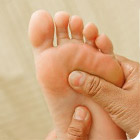 Using carrier oils when applying essential oils is a time-honored tradition when working with essential oils. It is felt by many aromatherapists, that because of the molecular structure of essential oils, the carrier oil enhances the trans-dermal delivery of the properties of the essential oils. Until recently (2016), respected aromatherapists allowed for neat (undiluted) application of an oil such as Tea Tree or Lavender for issues such as insect bites or moles, but we now feel that due to an increase in sensitization issues being reported, it is best to dilute even these oils for these situations to avoid this risk. Any essential oil can become a sensitizer, especially with undiluted or prolonged use. Risk can be affected by concentration, length of time on the skin, condition (health) of the skin and other factors.
Using carrier oils when applying essential oils is a time-honored tradition when working with essential oils. It is felt by many aromatherapists, that because of the molecular structure of essential oils, the carrier oil enhances the trans-dermal delivery of the properties of the essential oils. Until recently (2016), respected aromatherapists allowed for neat (undiluted) application of an oil such as Tea Tree or Lavender for issues such as insect bites or moles, but we now feel that due to an increase in sensitization issues being reported, it is best to dilute even these oils for these situations to avoid this risk. Any essential oil can become a sensitizer, especially with undiluted or prolonged use. Risk can be affected by concentration, length of time on the skin, condition (health) of the skin and other factors.
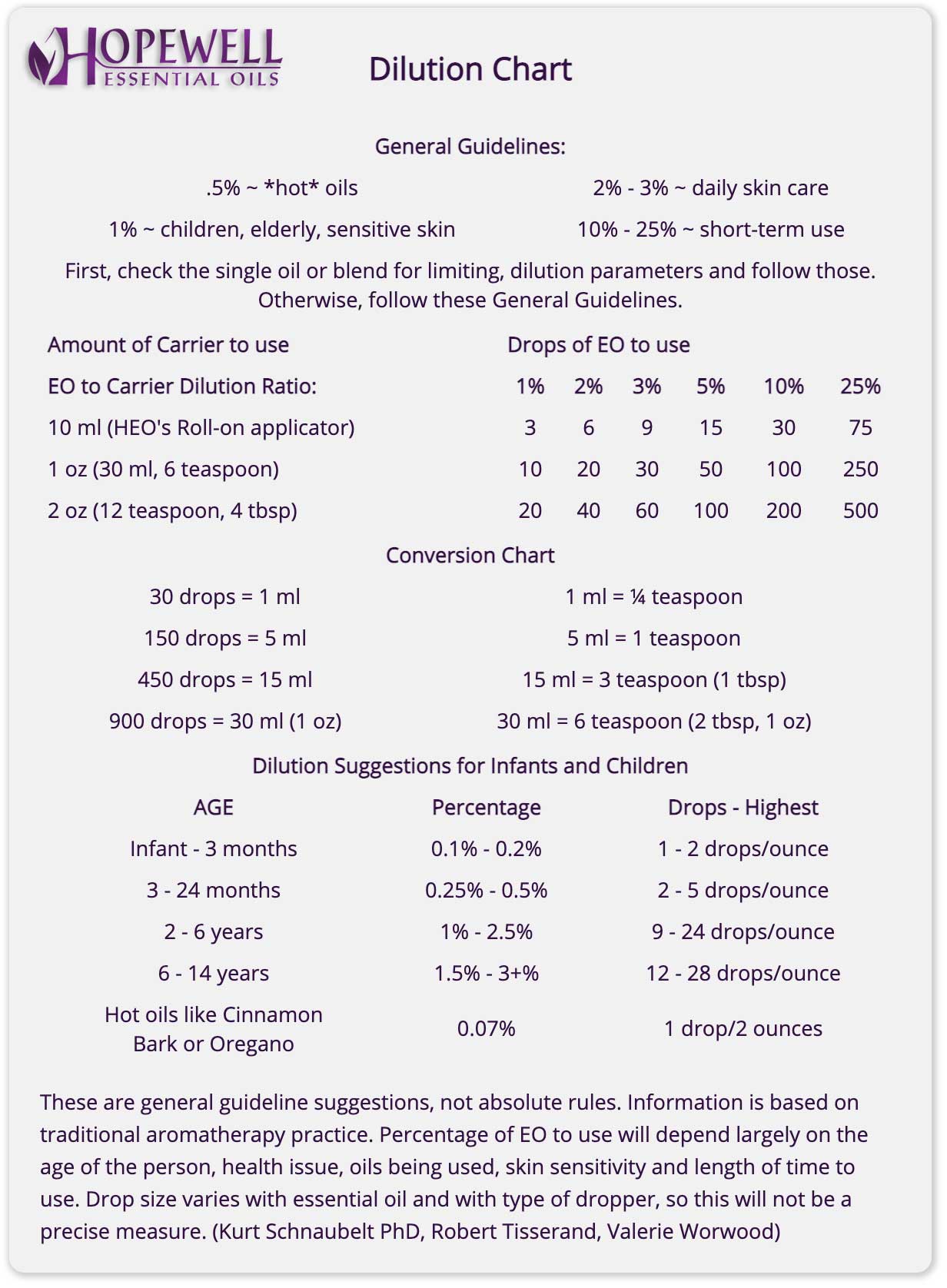
Jojoba liquid wax (usually referred to as 'oil') is an excellent choice as a carrier, as it has no scent, has an indefinite shelf life and has antioxidant properties, although there is a number of vegetable/nut/seed oils that can be used as a carrier. Virgin coconut oil has larger molecules that may interfere somewhat with the skin's absorption of essential oils, yet it is regarded for its moisturizing properties and is chosen for use as more of a moisture barrier than to facilitate absorption of essential oils, whereas fractionated coconut oil has smaller molecules and is structurally different from unrefined coconut oil making it a good choice if absorption is desired. For joint pain, consider a carrier with anti-inflammatory properties such as infused Arnica oil or Emu oil.
Using a carrier oil lessens the potential intensity of irritating oils, so when applying potentially-irritating essential oils to the skin, we suggest that you dilute 1 drop in about two ounces of carrier oil. Apply to a small area of the skin first to see how your skin responds. For other essential oils, dilute 14-20 drops to 1-ounce (2-tablespoons/30-ml) for daily skin care. You can adjust with more or less carrier oil once you see how your body reacts and according to the need.
In his Complete Skin Care Series, Robert Tisserand shares that research showed that 1% Lavender was as effective for inflammation as it was undiluted. He also notes in a discussion about athlete's feet that a 25% dilution of Tea Tree was effective and there was only a marginal gain with 50% dilution. The skin does not respond well to concentrated essential oil, and dilutions of essential oil are generally more effective. The risk of adverse reactions is increased significantly with improper dilution, especially with repeated use.
Dr. Pam Taylor, a practicing naturopathic physician, feels that there is a power released from the essential oil when it's diluted or extended. She explains: "It is important to realize that the main reason to use nonirritant essential oils undiluted is generally convenience. The assumption that undiluted essential oils will work more efficiently is generally not true. Perhaps surprisingly, experience often indicates that diluted oil is more effective than undiluted. Such observations can be explained chemically in that certain molecules rearrange into less active forms when they are present in high concentration. The molecule curls up because it sees too many of its own kind. Diluted, it sees more molecules from other oils and it relaxes into a more stretched out and active form."
Most oils can be extended (diluted) and still be effective to meet the need. When we use a potentially skin-irritating oil such as Oregano, we dilute the heat and extend its possibilities. When we use Lavender after a shower, we extend it with a moisturizing oil and apply it as a skin moisturizer, or we extend Eucalyptus and apply it over our chest and back for a respiratory ailment.
Essential oils are lipid and are attracted to the skin, which is also lipid. A single essential oil may have over 100 constituents, and the smaller components slip through the layers of skin more quickly than the larger components which take more time or don't penetrate at all. Once these constituents make it through the layers of skin, they are taken up by blood capillaries and begin to travel through the body.

While it is rare, essential oil constituents can combine with skin proteins to produce an allergic reaction (this is known as 'hapten'). Aromatherapist Shirley Price suggests that you put just a dab of diluted essential oil on the inner elbow to test for a reaction. A small number of people (0.1%) have a skin redness reaction to appropriately diluted essential oils.
Some people are more sensitive than others. Ultimately the user must be responsible to take the precautions necessary to avoid misusing the oils or experiencing discomfort. Use special caution when applying the oils on children or those who may not be able to adequately communicate discomfort.
For babies and small children, we prefer to use hydrosols and essential oils noted to be safe when appropriately diluted and avoid using potentially irritating oils such as Cinnamon Bark and Oregano. For the very young and elderly we use greater dilution than for adults. Less dilution is needed as children mature. The skin and organs of a newborn are very tender, and it seems best to use these potent essential oils with the greatest dilution possible to achieve the desired results. With this as the basis of usage, consider the need and the guidelines in the chart above and follow what you feel as the Lord leads. Always test your application on yourself first and then a very small area on your baby to be sure their skin will tolerate it. When applying the diluted blend on babies and small children, apply to the feet, legs and back (areas you can cover with clothing/socks) to reduce the risk of the oil getting into the mouth or eyes. Worst case, it will be briefly unpleasant, but certainly worth avoiding if possible.
Use a carrier oil, not water, to dilute any unpleasant effect. Water is not a good choice for diluting an irritating oil because it traps the oil and drives it against the eye or skin.
These commonly used, potentially skin-irritant essential oils should be appropriately diluted for topical use:
Aniseed
Bergamot
Cassia
Cinnamon Bark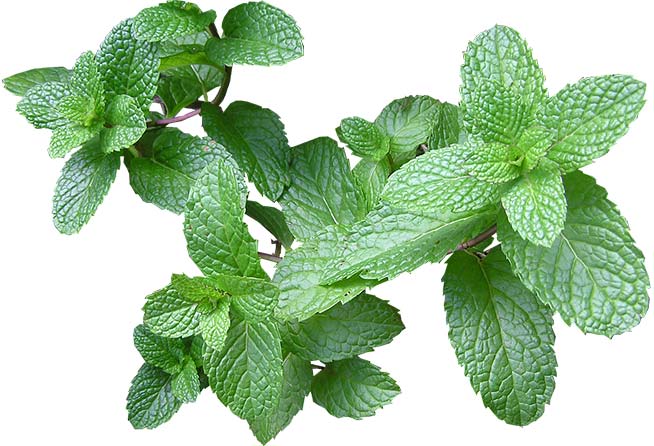 Clove
Clove
Lemongrass
Oregano
Peppermint
Rosemary
Sage Dalmation
Thyme ct.thymol
Birch/Wintergreen
Ylang Ylang
"Sensitization is a process that leads to an overshooting immune response. With respect to essential oils, this means they might be tolerated initially but can cause disproportionately strong dermatitis reactions with subsequent uses, even in response to minute concentrations. Some oils, especially Cinnamon (bark and leaf) and Clove (bud, stem, and leaf), statistically have the capacity to sensitize more than others. If used on the skin in concentrations above 2 percent, Cinnamon and Clove are considered potential skin irritants, meaning they will elicit an inflammation response from everyone, not just those who have become sensitized to them. Most interestingly, these effects are related to topical application; it appears, from experience in the aromatherapy community, that the internal application does not carry the same risks."7
Once you gain personal experience using the oils, you'll learn which oils you find most helpful and how best to dilute them for your need. To avoid skin sensitization, consider following the dilution rates for long-term use.
Therapeutic Bath and Shower
Bath
2 cups Magnesium Chloride or Epsom Salt (or perhaps a cup of magnesium and a cup of Himalayan or sea salt)
1 TB Fractionated Coconut oil or foaming products such as Castile Soap, Shampoo, Shower Gel
5-20 drops Essential Oil (1-4% ratio). Choose oils that are gentle on the skin that you've tested and know will be well tolerated.
½ cup Apple Cider Vinegar (optional)
Combine the essential oil with the carrier, then add to the salt and combine. Add to hot running water. We like to get the bath water as warm as tolerable and then soak for at least 20 minutes for the full effect.
Magnesium Chloride or Epsom Salt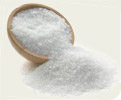 liver supportive
liver supportive
muscle relaxant
pain reducing (fibromyalgia, arthritis, muscle soreness)
bronchodilator (may reduce asthma attacks)
shingles (may reduce the severity of symptoms)
Shower
For the first time, start with a couple of drops of the diluted essential oil/blend of your choice) and apply to a small area of your skin. Once you are certain how your body will tolerate this application, then proceed as described.
After washing and rinsing, turn off the water. Apply a drop or two at a time to the feet, up the legs, abdomen, back, over the liver, chest, underarms and throat (avoid tender tissues). Ultimately you'll likely apply about 20 drops of essential oils. Turn the water back on. Continue to work the oil over your body as desired.
Essential oils for Bath/Shower
(Choose oils that are refreshing and gentle on the skin.
This is just a sampling of choices offered by Kurt Schnaubelt, PhD.9)
Black Spruce - adrenal tonic
Cardamom - cramps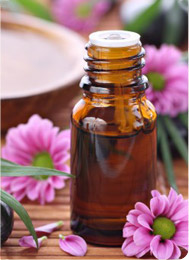 Clary Sage - relaxing
Clary Sage - relaxing
Cypress - decongestant
Eucalyptus Radiata - highly antiviral, easy on the skin
Geranium - relaxing
Lavender - relaxing
Myrtle - lungs and thyroid, easy on the skin
Niaouli - invigorating, broad reasons to use
Palmarosa - immune system boost
Petitgrain - relaxing
Pine - adrenal tonic
Ravintsara - immune system boost, nerve tonic, easy on the skin
Roman Chamomile - relaxing, easy on the skin
Rose - nerve tonic, relaxing
Rosemary ct. verbenone - mucolytic (it is very important to use the chemotype verbenone)
Tea Tree - cleansing, may be irritating to some
Thyme ct. linalool - candida (it is very important to use the chemotype linalool)
Once you are comfortable using the oils in a bath or shower, you'll discover which oils suit you best. Explore the possibilities slowly, and you should feel the reward.
Internal Use
There is some debate amongst aromatherapists regarding the safe use of essential oils internally. However, in 1996 Michel Vanhove-Geert Devlieghere spoke at the First Australasian Aromatherapy Conference: "The anxiety about internal use of essential oils is due to a lack of knowledge." It is his contention that ingestion of essential oils may, in some circumstances, be safer, or more desirable, than topical application.
Compared to the vast number of essential oils available, there are relatively few that are possibly not suitable to be taken internally. When an oil has produced negative reactions, it's possible that they were of inferior quality or not used within safe parameters.
We feel that internal use is rarely *needed* and should only be used with respect for how concentrated the oils are. HEO does not advocate internal use of essential oils without appropriate knowledge and understanding of how to administer them, for what purpose, how much, which essential oils, safety concerns and so on. In our experience, essential oils are generally more effective used topically with proper dilution or inhaled, but there are some issues where oral use is preferred. Kurt Schnaubelt, Ph.D. notes that "French aromatherapy literature contains many references to using oils orally." He goes on to note that "generally 1 drop is always enough when ingesting essential oils." A potential toxicity hazard could occur when untrained people use essential oils orally and ingest too much. Keep in mind that while medical doctors or health care practitioners may prescribe essential oils for internal use, they are trained and experienced in the safe application of essential oils. It is not a matter of using "French" or "British" methods, it's a matter of experience and appropriate application.
Robert Tisserand, essential oil safety expert and co-author of Essential Oil Safety, wrote in his Master Safety Class (2022): "Ingestion is a good modality due to its high bioavailability, is a good way to control dose, is often preferred for treating internal infections, is the best way to access the digestion system and avoids the risk of topical adverse reactions. The problem with internal damage, as opposed to skin irritation and allergy, is that we may not see it happening until it is too late. Liver toxicity, fetotoxicity, drug interactions and carcinogenicity, for example, are not obvious when the damage is being done.” Tisserand continued: "Potential risks [with ingestion] are: inappropriate dosing, ignorance of contraindications and side effects, gastric irritation, hepatotoxicity and potential drug interactions.”
Common Methods for Internal Use:
If ingesting *irritating* essential oils such as Cassia, Cinnamon Bark, Clove, Hyssop, Lemongrass, Oregano, Peppermint, Rosemary, Sage, Thyme or Birch/Wintergreen, use extra caution and dilute accordingly.
Generally, 1 drop is sufficient when ingesting essential oils.
1. Add 1-3 drops (depending on the need and the oil used) to an empty capsule and dilute with a carrier oil such as olive oil.
2. Drop a single drop (diluted if *irritating*) on a charcoal tablet, then put directly onto the tongue and hold the tongue to the roof of the mouth for quick absorption. Avoid getting the oil on your lips or it may briefly cause discomfort). This method allows the effectiveness of the oil to be maximized by being absorbed into the mucus membranes, potentially delaying its absorption into the liver where it is metabolized and the antimicrobial, mucolytic qualities possibly lost or reduced.
3. A drop or two in a teaspoon, add a bit of honey, lick off with the spoon upside down to avoid the lips and swallow. This method transports the oil to the small intestine.
4. Add a drop on a charcoal tablet or piece of bread.
5. Kurt Schnaubelt suggests that one add 1-3 drops to a glass of water or suitable liquid, stir vigorously and drink (never plastic or styrofoam). This oral-use method carries the most risk, and we'd suggest you use one of the above methods instead.
Suppository
Pneumonia, chronic bronchitis and lung congestion respond very quickly to essential oils when delivered by suppositories. The essential oils bypass the liver and are fed directly into the heart-lung circulatory system. Thus, they reach the lower bronchial capillaries in their original lipophilic and volatile state,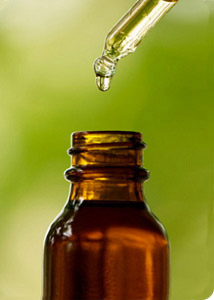 still capable of eliminating pathogenic microorganisms and dissolving and expectorating mucus. If helpful, a suppository can be used every 1-2 hours as needed. A quick way to accomplish a suppository is to put 1-3 drops of Hyssop var. decumbens, Rosemary ct.verbenone, Myrtle or another mild oil of choice into an empty capsule and fill the rest full with a carrier oil such as Olive or Castor oil. Lubricate the capsule liberally and insert. Lie down or recline for about 30 minutes as the essential oils dissolve the capsule and move into the lungs. Always test your application on yourself before you apply to your child. Adjust the dilution if needed.11
still capable of eliminating pathogenic microorganisms and dissolving and expectorating mucus. If helpful, a suppository can be used every 1-2 hours as needed. A quick way to accomplish a suppository is to put 1-3 drops of Hyssop var. decumbens, Rosemary ct.verbenone, Myrtle or another mild oil of choice into an empty capsule and fill the rest full with a carrier oil such as Olive or Castor oil. Lubricate the capsule liberally and insert. Lie down or recline for about 30 minutes as the essential oils dissolve the capsule and move into the lungs. Always test your application on yourself before you apply to your child. Adjust the dilution if needed.11
What Is a Harmful Dose?
When used appropriately, essential oils prove beneficial, but when used outside of safe parameters and reason, they can be harmful. As an example, water is beneficial and harmless when consumed in common amounts but can prove fatal when consumed in inappropriate amounts (Death of a Contestant in KDND Radio Contest). Both Eucalyptus and Pennyroyal essential oils, for example, have been fatal in 1-oz doses. An ounce is about 600 drops (two tablespoons) of essential oil, which is certainly an unreasonable amount of oil! Tisserand notes that essential oils, as used in aromatherapy today, have not caused a single death.12
Please Note: Essential oils dissolve plastic, so they are not suitable to be used in plastic drinking containers, humidifiers, CPAP masks and asthmatic nebulizers.
Inhalation and Diffusing
If the goal is to get the essential oil into the bloodstream, inhalation is the most efficient way to deliver essential oils to the whole internal system of the body as they cross into the bloodstream through the lungs. The internal lining of the respiratory system is a mucous membrane, which is thinner than our external layers of skin, so inhaling essential oil has much quicker access than topical application. This rapid absorption into the bloodstream has a direct effect on infection and congestion within the respiratory system and on the central nervous system. Also, inhaled oils interact with cells at the back of the nose and can stimulate a change in the areas of the brain that control nausea and vomiting as well as sleep and mood. Inhalation is the safest method of essential oil use (although those with asthma or severe allergy sensitivities may have issues to consider).
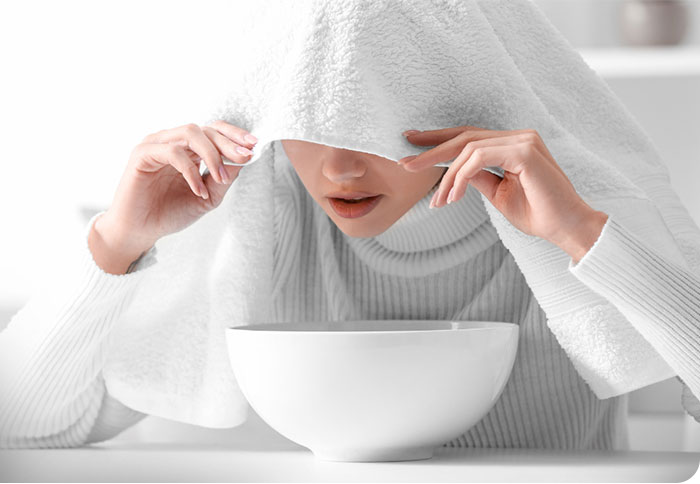
Steam Inhalation
Steam inhalation is a simple way to support your respiratory system with essential oils. It's a quick and convenient method to use after flying or being in crowded public places, especially around folks sniffling with allergies or colds. Steam inhalation helps to clear sinuses and mucous membranes and may help us avoid respiratory illness and clear nasal congestion.
In a non-reactive soup bowl or coffee cup (choose something suitable for essential oils, not plastic), pour boiling water and add 1-2 drops of a respiratory-supportive essential oil. Have some tissues handy, and sit comfortably on a chair with the bowl/cup on a table before you. Close your eyes and place your face about 8-12 inches over the bowl. Drape a towel over your head and the bowl, covering the base of your neck. Breathe in the vapors for about a minute or as long as you feel comfortable. You can move closer to the steam if it feels comfortable and desirable. Uncover your head for a few moments to get some fresh air, then repeat this cycle for 5 to 10 minutes, as desired. (This may be irritating for folks with asthma.)
Hopewell has a good selection of oils that are appropriate to use via steam inhalation. Some of the most popular are Respiratory Relief, Lung Support, Breathe Happy, Breathe Easy, Sinus Relief and Nasal Rescue. Good single oil choices include Cajeput, Eucalyptus oils, Myrtle, Tea Tree, Black Spruce, Fir oils, Lavender, Lemon, Peppermint, Pine, Thyme ct linalool, Ravintsara, Roman Chamomile, Spike Lavender and Cedarwood Atlas. These oils are noted for their antiseptic, antimicrobial, analgesic and decongestant properties.
Aromatic Diffusion
Other than simply inhaling the oils, one of the easiest and simplest ways of putting essential oils into the air for inhalation is to use an aromatic diffuser. A cold-air diffuser uses room-temperature air to mist the oil up through a nebulizer/atomizer. This creates a micro-fine mist that is dispersed into the air. The oils will then remain suspended for several hours to freshen and improve the quality of the air. Essential oils’ antiviral, antibacterial and antiseptic properties may help reduce bacteria, fungus and mold. Essential oils, when diffused, have been found to reduce the amount of airborne chemicals. Many essential oils, such as Lemongrass, Lemon and our blends of Purify, Citrus Blessing, Immune Support and Plague Defense are highly antibacterial and may effectively eliminate airborne germs and bacteria.
When using on a daily basis, we suggest a very low level of diffusion so that the aroma of the essential oil is faintly noticeable, which in an average-size bedroom would only diffuse a few drops daily. Daily diffusion over many weeks or months may not be in the best interest of most children, as we feel it's important for their immune systems to be challenged so that it learns to fight. Intermittent diffusion is suggested where the diffuser cycles on for a time, such as 20 minutes on and 20 minutes off. In our family, we diffuse 5 minutes on and 20 minutes off. Intermittent diffusion is effective and safe for children.
There are times when we want to diffuse to support our immune response or recovery from an illness. Robert Tisserand: "Intermittent diffusion is much more effective, as well as being safer, than continuous diffusion. Intermittent means 30-60 minutes on, then 30-60 minutes off. This is because our body, especially our nervous system, habituates after this length of time. With continuous diffusion, while benefits do not increase, there is evidence that the body becomes stressed in various ways. However, very low levels of diffusion, so the essential oil is barely noticeable, are fine anywhere, for any length of time." Low-level, intermittent diffusion is effective and safe for children.
Unlike candles or aroma lamps, cold-air diffusers disperse oils without heating or burning, which can render the oil therapeutically less beneficial and possibly create toxic compounds. Burned oils may become carcinogenic. Cool, micro-mist (atomization) is considered the best way to provide both aroma and therapeutic and/or value with essential oils. It does not alter the chemical composition of the oils, while it breaks down the molecules and produces a particle size small enough for the lungs and body to absorb rapidly.
Research and/or antidotal testimonies demonstrate that cold air diffusing certain oils may:
• Reduce and eliminate bacteria, fungus, mold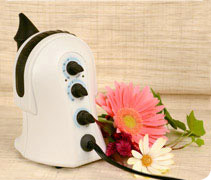 • Relax the mind and body, relieve tension and clear the mind
• Relax the mind and body, relieve tension and clear the mind
• Improve concentration, alertness and mental clarity
• Stimulate neurotransmitters
• Stimulate secretion of endorphins
• Stimulate growth hormone production and receptivity
• Digest petrochemicals on the receptor sites
• Improve the secretion of IgA antibodies that fight candida
• Improve digestive function
• Improve hormonal balance
• Relieve headaches
• Dispel odors
Spa-type diffusers (vaporization) combine essential oils with water and produce a mist with an ultrasonic wave assisted by a fan to force the mist into the environment. This is considered by some to be a less effective way to provide therapeutic aromatherapy because the majority of the mist is water vapor which quickly drops from the air to the floor.
Some ask if they can put essential oils into their humidifier. Keep in mind that essential oils may degrade the plastic part which may damage your humidifier if combined with the water. Also, essential oils may degrade plastics in CPAP masks and nebulizers used by asthmatics.
~~~~~~~~~~~~
It is our hope and prayer that you will experience the wonderful blessings of essential oils and that the Lord will bless all your efforts to help your loved ones stay healthy.
Linda and the HEO crew
___________________
Reference
1 Schnaubelt, Kurt, Ph.D. The Healing Intelligence of Essential Oils, Healing Arts Press, 2011, p. 31.
2 Price, Shirley and Leon, Aromatherapy for Health Professionals, p. 67.
3 Stewart, David PhD., D.V.M., The Chemistry of Essential Oils.
4 Schnaubelt, Kurt, Ph.D. The Healing Intelligence of Essential Oils, Healing Arts Press, 2011, pps. 74-76.
5 Ibid, p.24.
6 Ibid, p. 139.
7 Ibid, p. 81.
8Ibid, p. 128-129.
9 Ibid. p. 124-125.
10 Ibid. p. 131-134.
11 Ibid, p. 137.
12 Tisserand, Robert, Challenges Facing Essential Oil Therapy: Proof of Safety, Presented to the Alliance ofInternational Aromatherapists (AIA) Conference in Denver, Colorado, October 18-21 2007.
13 NATURE’S MOLD RX by Edward R Close, Ph.D., and Jacquelyn A Close
- Stimulate Neurotransmitters
- Stimulate secretion of endorphins


